Dee Estuary Birding
Monthly Newsletter...
February 2024
Newsletter
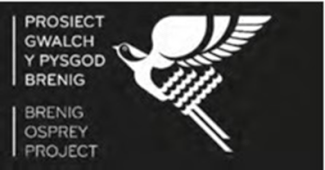
Ospreys
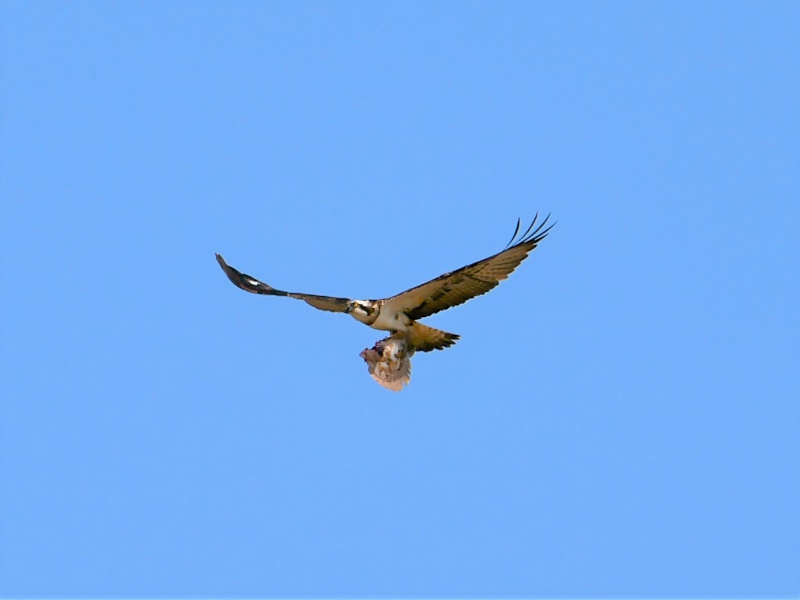
It is this female Osprey which is described below as quoted from the Lighthouse birders Blog (April 2018)
"A fantastic weekend of
migration
started late Friday
afternoon when a male Osprey flew east over two observers along Park
Lane. Like buses a second Osprey was found on the tide line on Friday
14th. This second bird (a female) then flew directly towards observers
standing on the sea defence where it landed and devoured a large
Flounder; much to the delight of the regulars and a very fortunate
visiting RSPB group. After 30 minutes on show the bird eventually
flew off and was picked up over Seaforth. Ospreys are becoming more
regular on Wirral these days but it's always a thrill to see them on
patch."
I came across the above piece whilst looking for good photos of Ospreys in the Lighthouse Birders Blog and liked it so much I had to reproduce it in this newsletter. We always love to see Ospreys and 2023 was a record year for them here on the Dee Estuary and North Wirral as shown in the bar chart below.
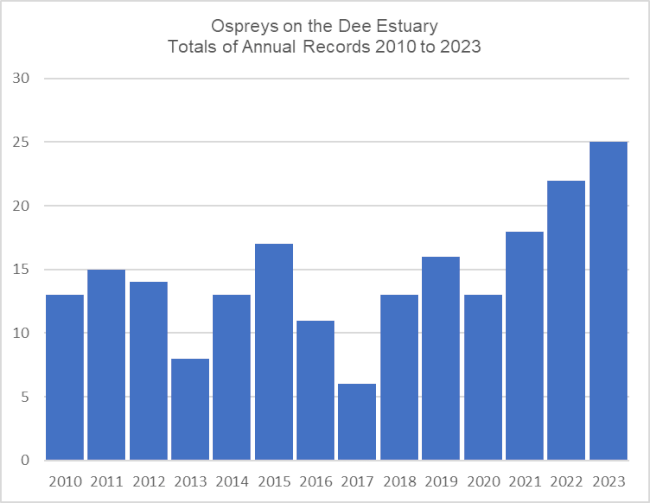
Between 2010 and 2020 numbers flying
over here on
passage had plateaued out at an average of about 13 a year, but there
has been a strong increase in the past three years with a record
25 in 2023. This increase has no doubt been fueled by the
increase in breeding pairs, particularly in England and Wales where
total confirmed breeding went up from 11 pairs in 2010 to a
remarkable 36 pairs in 2023. Reintroduction/Translocation schemes, such
as at Rutland Water and Poole Harbour, have not only helped this
increase in breeding but also must have contributed to the general
increase in the number of sightings with young birds wandering across
the country looking for potential mates and prospecting for nest sites.
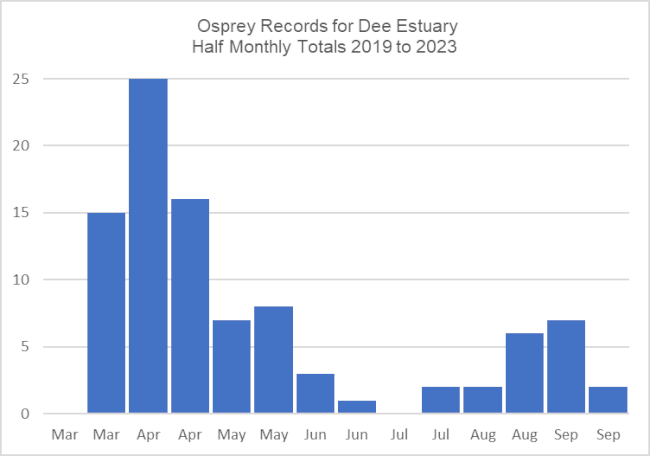
The above bar chart I find intriguing.
We always see
more Ospreys in spring than on the return passage, but this is strange
as with nearly all other species it's the other way round with birds
flying through quickly in the spring, in a hurry to reach their
breeding sites, whilst the return journey is not only far more
leisurely there are also more birds with juveniles as well as the
adults present. We think there are two reasons for more Ospreys in
spring - the first is that in spring they take a long journey up from
Africa with
many flying over the Bay of Biscay followed by a flight across the
English Channel and then inland over England and Wales, so by the time
they reach
the Liverpool Bay area they are more than ready to pause and catch some
fish to feed on, and we often do see them catch and eat fish here as
per the bird in April 2018. The second reason is that young un-paired
Ospreys will be looking for mates and prospecting for nests, and these
latter will account for nearly all the birds we see in May and June.
The breeding season for paired adults is well underway by late April,
over the past three years both adults have arrived at Llyn Brennig by
mid-April.
On the return journey, after breeding, the Ospreys will be well fed,
and are not looking for mates or nest sites, so just fly through
without pausing.
It is feasible that one day Ospreys will nest here, there appears to be plenty of good size fish for them in the sea and it would be easy enough to build a nesting platform for them at a safe site. Nesting Ospreys are certainly getting nearer with the closest site to the Dee Estuary just over an hour's drive away at Llyn Brenig in Denbighshire and below is an article all about the Llyn Brenig Osprey Project. They are looking for volunteers so if you can spare some time during the breeding season it will be very much appreciated and you will have the chance to spend many hours looking at these wonderful birds.
Richard Smith
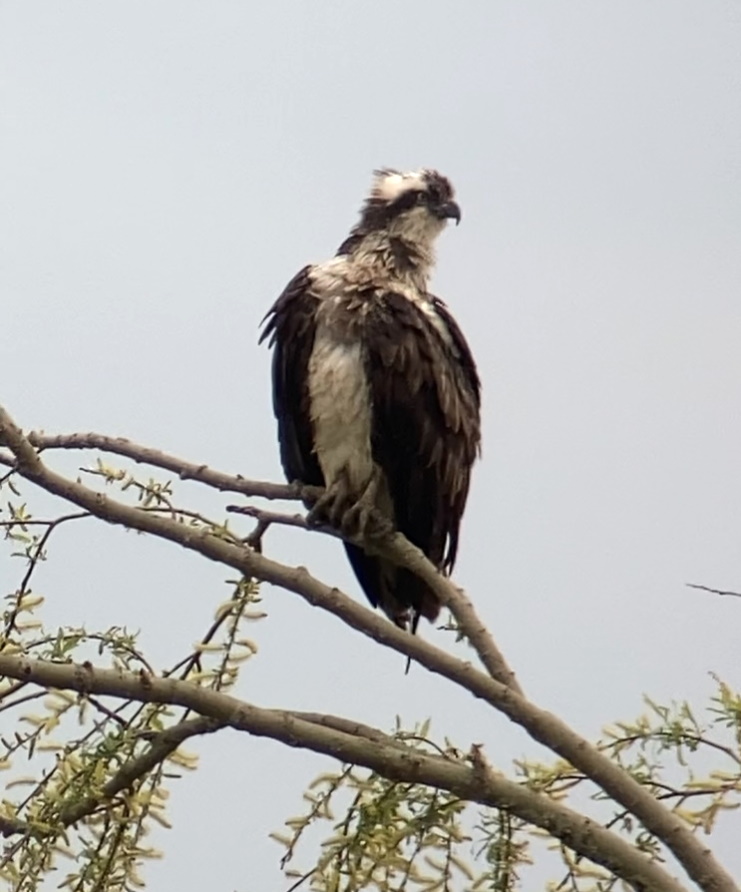
This Osprey spent the night in a tree at Meols which I think is the first record of an overnight stay in our area for this species
Llyn Brenig Osprey Project
The osprey, a majestic and magnificent bird driven to extinction in Wales but now is making a comeback due to the efforts of conservation projects like the Brenig Osprey Project, writes Sarah Callon, North Wales Wildlife Trust’s BOP Project Officer.
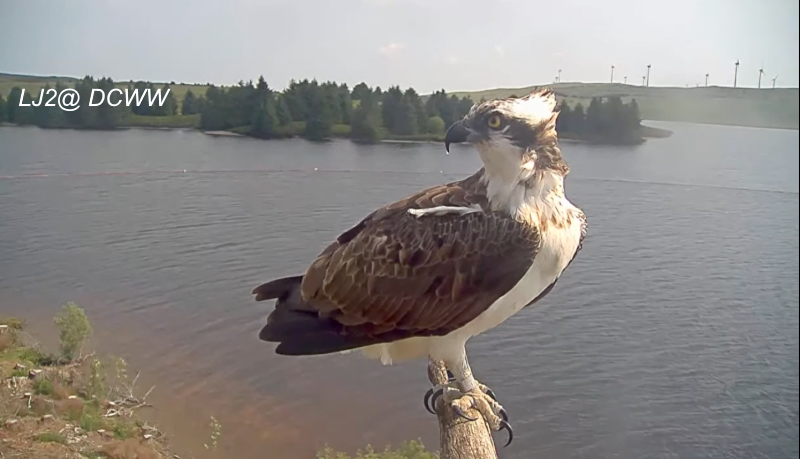
The Brenig Osprey Project was started in 2013, a partnership project
between North Wales Wildlife Trust and Dwr Cymru Welsh Water, at the
water company’s visitor attraction Llyn Brenig. Five nests
were
erected as ospreys had been previously spotted in the area.
In
2015 one of the nests was chosen by CU2
“Jimmy”.
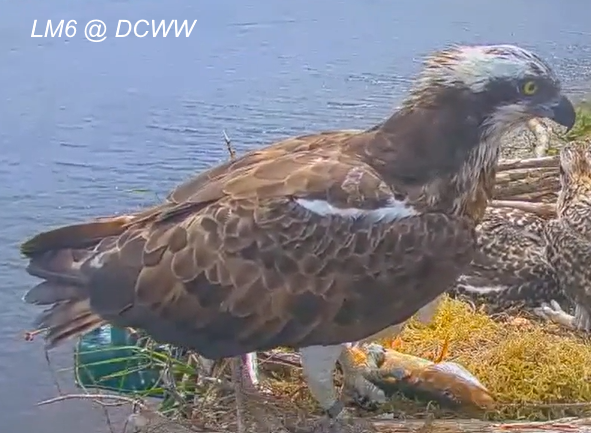
In 2017 a pair, female Blue 24 and male HR7, visited the Brenig nest (Blue 24 hatched at Rutland Water in 2010, granddaughter to White 03(97) a male osprey who was translocated to Rutland Water in 1997). To everyone’s delight in 2018 the first chick at Llyn Brenig was hatched; Blue Z9. Blue 24 and HR7 hatched one chick, KA5 Roli, in 2019 and another, Blue KC5 Dwynwen, in 2020. Sadly Blue 24 and HR7 did not return from migration in the spring of 2021.
2021 saw two new ospreys take over the Brenig nest; female Blue LM6
hatched in Menteith, Stirling in 2018 and male Blue LJ2 hatched in
South
Argyll in 2018.
Everything was going to plan for this new breeding pair and on the 30th
April 2021 LM6 laid her first egg. That evening, however, in
devastating and dramatic circumstances, the
nest pole was illegally felled with a chainsaw. A terrible
wildlife crime had been committed and the newly laid egg was
lost.
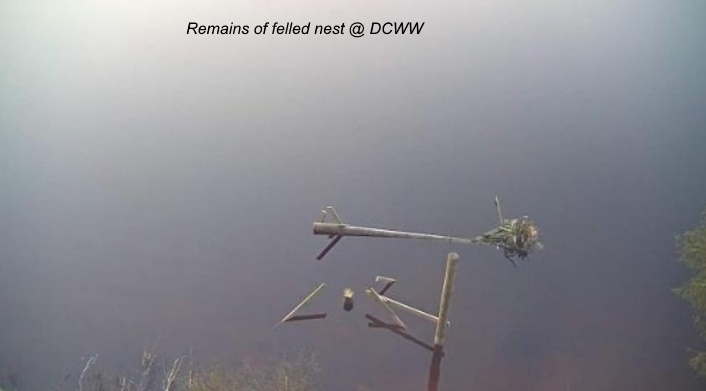
A temporary replacement nest was put up in the hope that the pair would lay more eggs but they did not. A tremendous public reaction of support and donations meant that 24-hour security could be put in place to prevent this happening again. LM6 and LJ2 did, however, stay around the area and set off for migration. During that winter BT Openreach donated and installed a new nest pole, LM6 and LJ2 returned to the new Llyn Brenig nest in the spring of 2022, much to the project’s relief.
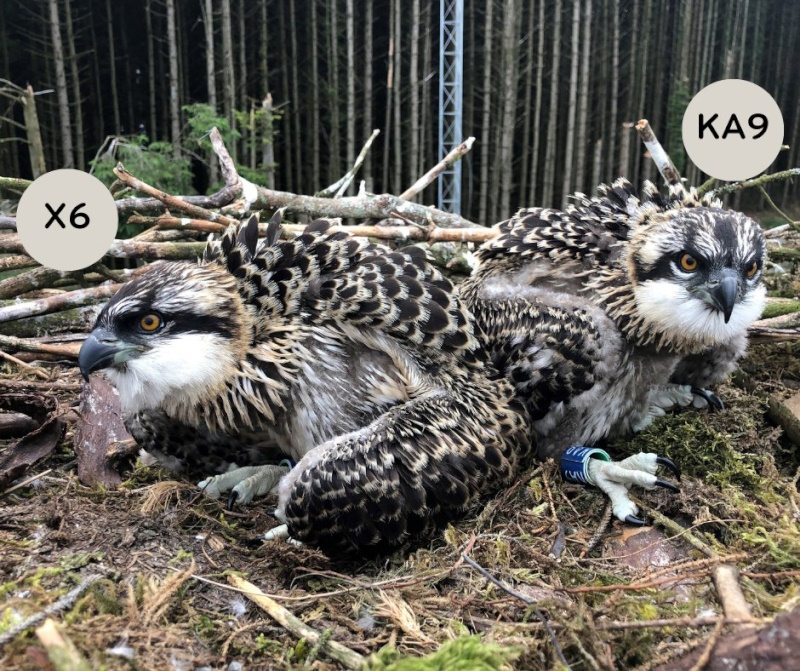
The 2022 season was a most successful season, especially after the devastation of the previous year. Two chicks were successfully raised by LM6 and LJ2 to migration; Blue X6 Olwen and Blue KA9 Gelert. We hope to see them return to the area in 2024 as two-year olds.
2023 was also successful season as
again two chicks
were raised to
migration; Blue 7B5 Dilys, hatched 27th May and last seen at Llyn
Brenig 30th August. Also, Blue 7B6 Mari, hatched 29th May and
last seen at Llyn Brenig 26th August.
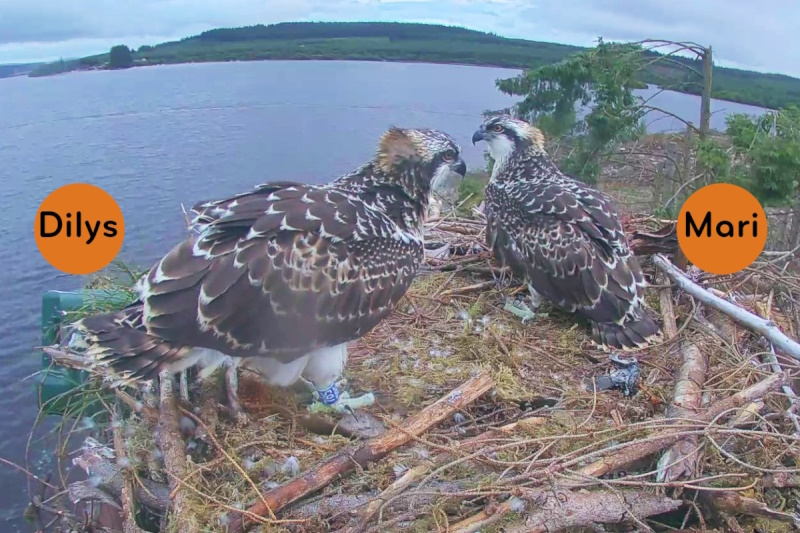
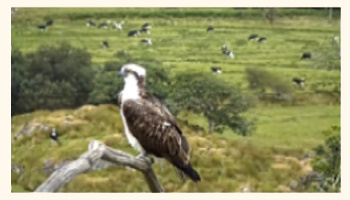 2023 also
saw the return
to Wales of 2020 chick, KA5 Roli. He was
spotted at the Glaslyn nest in July 2023 making a nuisance of himself
with the breeding pair. Great to see the first Llyn Brenig
born
osprey to return to North Wales.
2023 also
saw the return
to Wales of 2020 chick, KA5 Roli. He was
spotted at the Glaslyn nest in July 2023 making a nuisance of himself
with the breeding pair. Great to see the first Llyn Brenig
born
osprey to return to North Wales.
Can you help?
The Brenig Osprey Project relies on a
team of
dedicated volunteers who
give their time and expertise to the protection and conservation of
these beautiful birds. In return they learn about the Llyn
Brenig
ospreys, monitor osprey behaviour, help educate visitors about the Llyn
Brenig ospreys and their ongoing protection and conservation.
The
volunteers benefit from improvements in self-esteem, confidence and
wellbeing. They feel part of a community, feel valued and enjoy
being part of the North Wales Wildlife Trust team. The
stunning
scenery of Llyn Brenig and the surrounding area is also a great place
for our volunteers to spend their time.
We are always looking for more volunteers so if you have plenty of
enthusiasm, are happy speaking to the public, would like first-hand
experience of the exciting breeding season of the ospreys at Llyn
Brenig then come and be a part of it. If you don’t know much
about ospreys, that’s fine we can teach you that! Email
sarah.callon@northwaleswildlifetrust.org.uk
to
start your osprey
volunteer journey.
Sarah
Callon

Colour Ring Report
Curlew
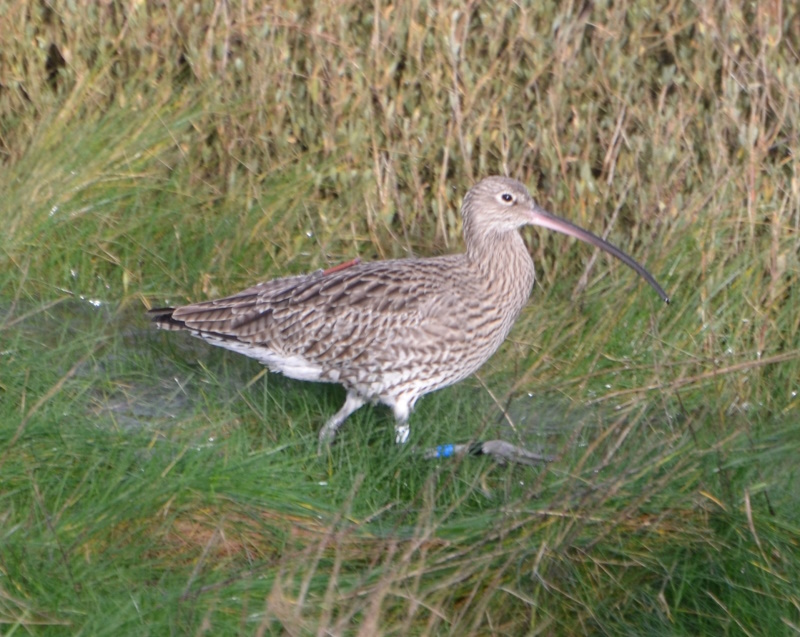
W/BN
with GPS transmitter
Recorded at Flint Castle on 14/01/2024.
An exciting find by Brian Kermode, we see very few colour-ringed Curlew
on the estuary (this is only the third one in our database) and we knew
when we saw the transmitter that we would be able to see a map where
this bird has been tracked - see below.
Chris Heward describes the history of this bird:
The bird was tagged on Abbeystead Estate in May 2023 in the Forest of Bowland, Lancs. She’s an adult female, caught on her breeding site. She went on to successfully hatch eggs. I know the bird as ‘Tower’, named after the field it was caught in.
She has been reported once before from her current location, on the 18th November.
The
bird is obviously tagged with a GPS-transmitter and I’m
pleased to say it is still operational. I’ve attached an aerial photo
showing her short-distance migration route from breeding to wintering
site. Sightings of the birds are still valuable to us, as it helps
confirm that the tag is not having an adverse effect, and can help us
understand the fates of birds whose tags fail/lose charge.
The map show the area 'Tower' was nesting in the Forest of Bowland with some movement around the area and a couple of visits to Morecambe Bay. After breeding she then flew to the Dee Estuary, between Parkgate and Flint, touching down on the Ribble Estuary and the outer edge of East Hoyle Bank (off Hoylake), on the way.
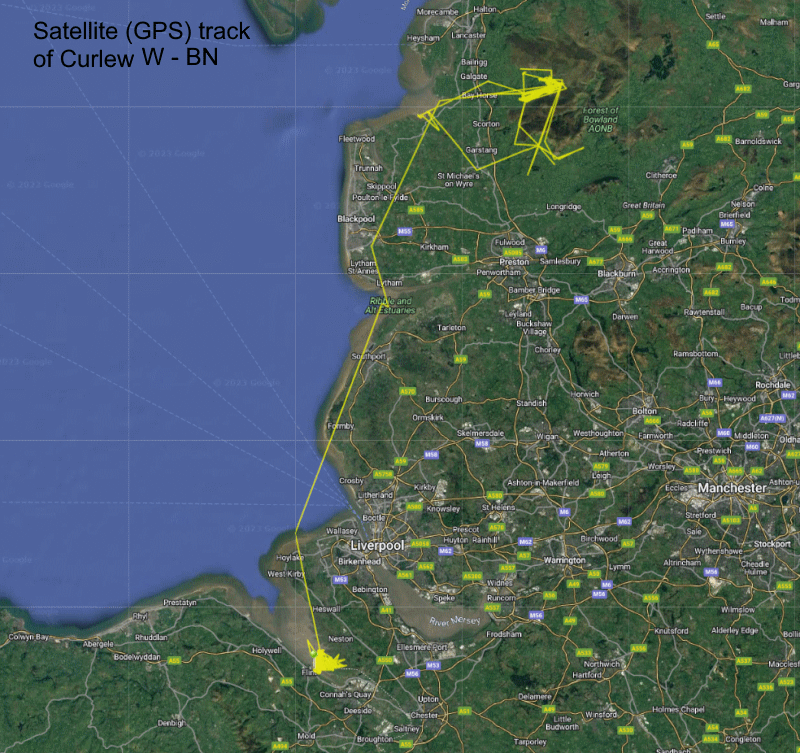
Black-tailed Godwit

O-YW//W
In contrast to the record breaking numbers of Black-tailed Godwits on
the estuary in the summer counts of over-wintering birds have been very
low, so it was good to see this colour ringed bird in a flock of 40 at
Thurstaston on January 20th.
It has an interesting history as described below:
Ringed at Snettisham, Norfolk, on
01/09/2019.
In November 2019 it was recorded on the north coast of France, in the
Mont St Michel area - this has been the only sighting of this bird
south of Snettisham.
It was recorded again at Snettisham in late summer and early autumn in 2020, 2021 and 2023. In 2021 and 2022 it then moved north to the Humber estuary for the rest of the autumn, but until this year's record at Thurstaston there have been virtually no winter sightings, at least until late February.
Spring sees it on the Lancashire coast and it's been spotted at several locations on the south coast of Morecambe Bay, including Leighton Moss.
There has been one record from Iceland when it was at Lake Myvatn in May 2022.
2023 saw it at Leighton Moss in April, at Snettisham in July and early August and the Humber estuary in November.
Oystercatcher
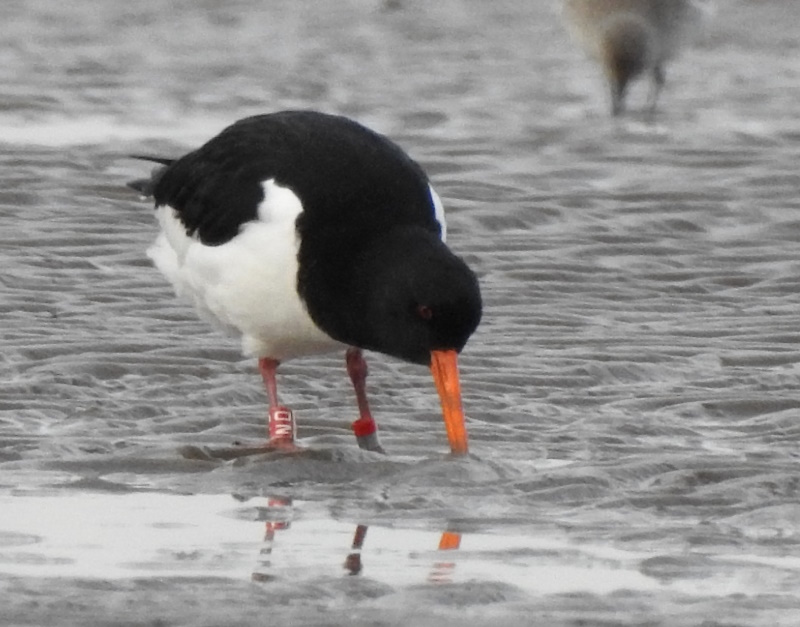
R-R(NO)
Ringed at a night-time roost on the bank of the River Spey just north
of Newtonmore, Inverness-shire on 17/03/2018.
Recorded at Thurstaston January and November 2020, and at Caldy on
08/01/2024.
Black-headed Gulls
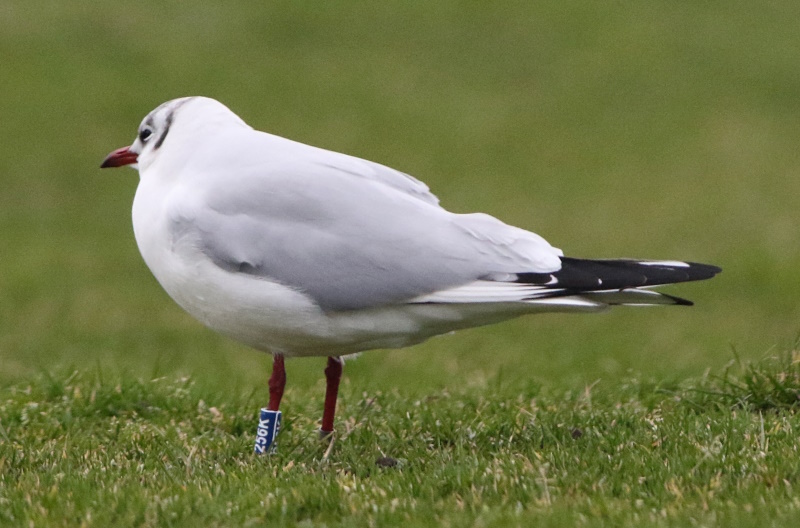
Two blue ringed Black-headed Gulls this month, both seen on the same day, both ringed by the Water Bird Colour-marking Group and both with a very similar code on their rings!
B-256K
Ringed at Bowness (Windermere) on 28/11/2023.
Recorded on the 'dips' at New Brighton on 19/01/2024 and 21/01/2024.
B-256L
Ringed at West Kirby on 17/12/2024.
Recorded on the pontoon at West Kirby Marine Lake on 19/01/2024.
Knots
There were 275 records of colour-marked Knots in January. Strangely, nearly all records in the first half of the month came from Thurstaston and West Kirby, whereas in the second half of the month the Knots were at Meols with just a handful seen on the estuary itself.
We recorded Knots which had been ringed at Ynsyshir (Cardigan Bay), Bangor Harbour, Hoylake, Altcar, Ainsdale, NE Scotland, Iceland, Norway, the Dutch Waddensea and Canada.
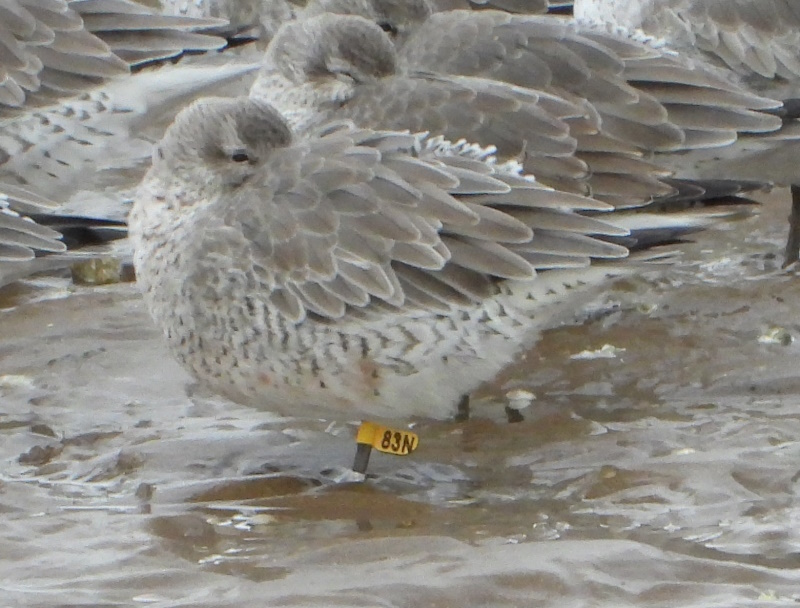
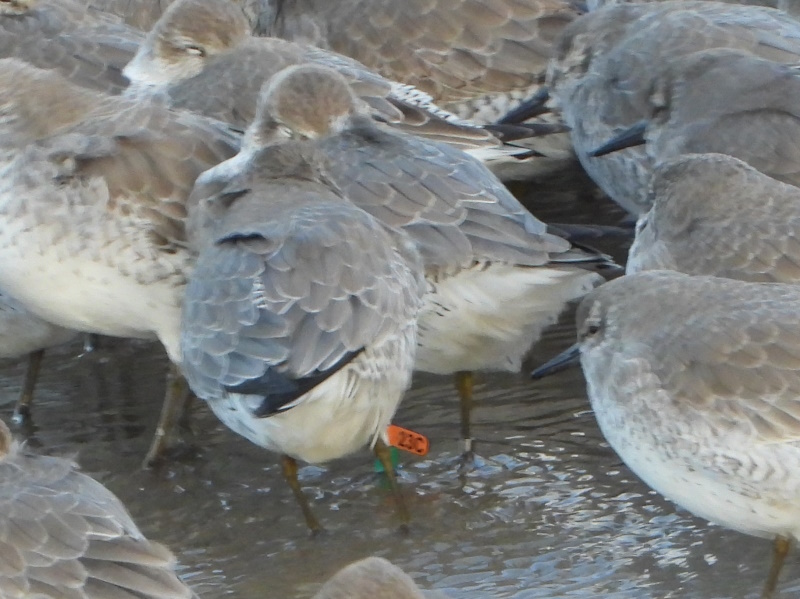

Yellow 83N ringed in Iceland, Orange 23C at Hoylake and Y6GNPR on the Dutch Waddensea. All photos above by Richard Smith.
The plethora of flags and rings used by
the
different schemes can be confusing, but all is explained by Rose
Maciewicz and Peter Knight in their excellent Photographic Guide to Colour-ringed Red Knot.
Colour Rings were recorded by Richard Smith, Stephen Hinde, Tony Ormond, Steve Williams, Brian Kermode, Matt Thomas and Sean O'Hara.
Richard Smith
January Bird News
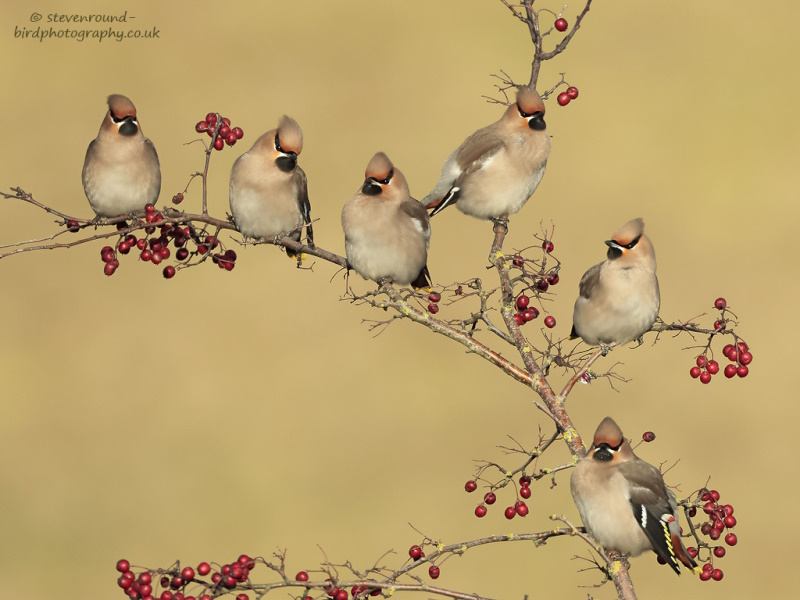
I know Halkyn Mountain well as a great
place for walking with good views over towards the Clwydian range to
the west and the Dee estuary to the east, but I had forgotten that the
place was full of Rowan trees! Anyway, the Waxwings
found them and it was good to see a large number in a natural
setting -
rather than a supermarket car park or industrial estate. Up
to 180 were there over the last ten days of the month.
A
drake Smew, less than annual in our area, was spotted at Talacre/Point
of Ayr on the 10th and was recorded there on several more dates, and
presumably it was the same bird which was also on West Kirby Marine
Lake on the 18th.
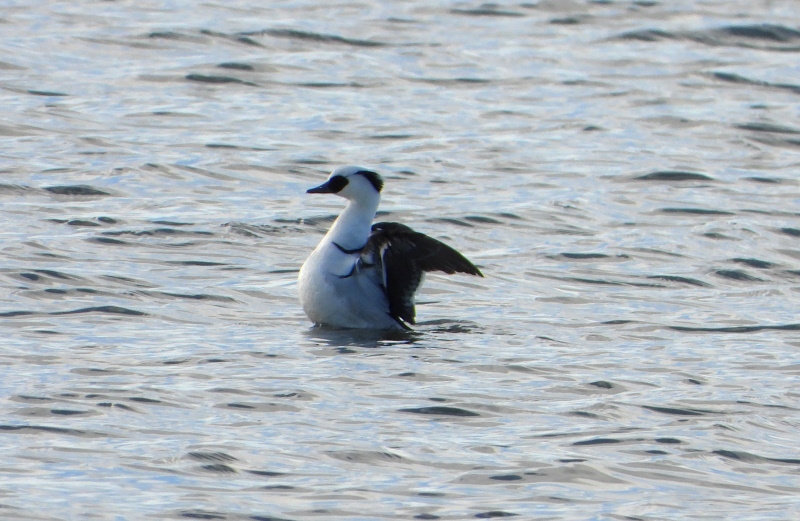
The next rare duck to turn up was an American
Wigeon recorded at Burton Mere Wetlands on the 22nd and 24th. It was
the 'Storm Wigeon' variant and appropriately arrived just after Storm
Isha had gone through. These Storm Wigeons, with much more white on
their heads than the normal American Wigeon, comprise just 0.1% of the
total population of American Wigeons so even in North America is
regarded as a rarity and exciting to see. Not quite as rare were two
Long-tailed Ducks off East Hoyle Bank early in the month.

A Slavonian Grebe was spotted from Hilbre on the
12th and 13th, and was briefly on West Kirby Marine Lake the next day
before being seen well on the sea off Bettisfield near Bagillt a
few days later.
Five Snow Buntings were at both Gronant and Point of Ayr, probably ten in total rather than the same birds moving between the sites.
Jane Turner got a shock when a Glaucous Gull flew right in front of her at Meols, luckily Martin Dohn was there with a film camera to record it - photo below.
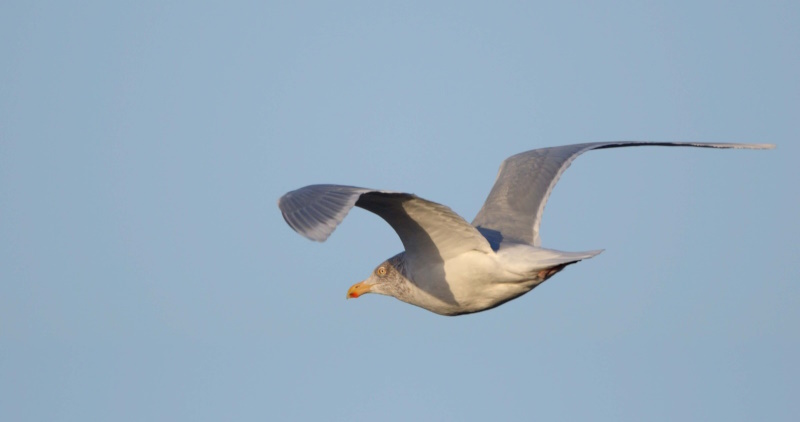
Also at Meols were the usual feeding and
roosting Knots, and they were often ridiculously close to the sea wall.
There were also plenty of other waders with the constant noise of
Oystercatchers and alarming Redshanks.

What to expect in February
Three big tides are due this month on
the 11th, 12th and 13th. The actual height will be dependent on the
weather, as always, but should be spectacular with thousands
of Pink-footed Geese, waders and wildfowl, plus Water Rails,
both Hen and
Marsh Harriers and Short-eared Owls. Most people head to Parkgate and
that should be particularly good for Water Rails if the tide reaches
the
wall, whereas a bit further north, on the footpath towards Cottage
Lane,
Heswall, is the best spot for Short-eared Owls. If it's anything like
february 2022, when there was a massive tidal surge, the sea can cover
the whole
of Burton Marsh.
Waxwings should still be about and numbers can even increase in late
winter as the birds start to move north back to Scandinavia. Two other
species to look out for that are starting to move to their breeding
grounds - numbers of Mediterranean Gulls will increase with many
starting to moult into summer plumage, and along north Wirral there
will be a noticeable passage of Stonechats which will continue into
March (see 'A day of Stonechats').
Sea-watching can be productive, if we get strong westerlies we can get Little Gulls, they won't be on passage yet but perhaps there is the beginning of a northward movement into the Irish Sea, also maybe our first Gannets of the year. When the sea is flat calm we can see large numbers of birds on the sea - these will be mainly Common Scoters which can be present in their many thousands, and also Velvet Scoters, Eiders (particularly off Hilbre), Long-tailed Ducks, Red-throated Divers and hundreds of Great Crested Grebes.
A mild spell at the end of the month could well result in the arrival of our first spring migrant - likely to be either a House Martin or a White Wagtail.
Forthcoming Events
February Highest Spring Tides (Liverpool)
Also see Tides page.
11th February, 12.06hrs (GMT), 10.0m.
12th February, 12.50hrs (GMT), 10.2m.
13th February, 13.33hrs (GMT), 10.1m.
14th February, 14.15hrs (GMT), 9.8m.
Forthcoming Events
High Tide Birdwatch
- Saturday 10th February, start 10.15am, high tide 11am. Join the RSPB,
Cheahire Wildlife Trust and Dee Estuary Voluntary Wardens at Hoylake
for what should be a spectacular show of waders over high tide.